Chichen Itza: Exploring the Famous Maya Site in 1995
We made it to the best-known destination of our honeymoon trip - before most tourists discovered it: Part 1: The Castillo - Travel Tales from the Land of the Maya #8
After exploring the tiny site of Ek Balam, we drove on towards Chichen Itza, our next destination.
We didn’t plan on visiting the site the same day (we couldn’t have if we tried), instead we stopped in Piste, the gateway town to the ruins.
We pulled up to the only hotel in town, the Piramide Inn, and after checking in and leaving our luggage in the room, we walked out onto the street.
It might be a large town now, but in 1995, Piste was a quiet village you could walk through without meeting too many tourists. We walked along the only paved road, lined by a tienda (small everything shop), a panaderia (bakery), and a tiny hole-in-the-wall eatery.
Welcome back to another installment of Travel Tales from the Land of the Maya, stories!
If you are new here or haven’t read any of the earlier installments, this is the story of my first trip to the Yucatan Peninsula on my honeymoon in 1995. To read the previous installments, click on the link above.
The mouthwatering aroma of fresh-cooked local specialties invited us to sit at one of the few tables lined up along the street. The only meals we could order were cochinita and pollo pibil, and pok chuc, which was perfect for us, since that’s what we would’ve looked for, anyway.
Our meals were delicious, and we enjoyed sitting along the road, even with the noise and smell of traffic driving by. Truthfully, though, I only enjoyed it because it was so new to me, but the traffic, especially the smell of car exhaust, did take away from the experience.
We met several European travelers (not even one American) in town, there to visit Chichen Itza.
One of the more memorable characters we talked to was a German expat, working as a guide to Chichen Itza, leading tours in German, Spanish, and English. He was the first expat I met in Mexico (though we didn’t use the word expat in those days - I wouldn’t have known what it meant). Perpetually sunburned, he lived in Piste, knew everyone in town, and knew as much about the ancient Maya and Chichen Itza as was possible. I remember him so well, since it was an anomaly in those days to see a foreigner living in Mexico like a local.
The Ruins
Early next morning, we set off to visit the ruins, getting to the gate soon after the site opened. (In subsequent years, we got there at least half an hour before opening time to find a parking spot and stood in a long line before the locked gates, waiting for them to open.)
In 1995, crowds were not a problem at Chichen Itza; only those truly interested in the ancient Maya civilization took the time to visit the site (besides a handful of tourists who came on tour buses from Cancun for a short time).
We knew one day would not be enough for us to explore the site, so we spent two days exploring Chichen Itza.
One of the New Seven Wonders of the World, designated in 2007, Chichen Itza showcases some of the best-preserved monuments of the ancient world. It became extremely popular after this designation, to the point of necessary restrictions on getting close to the structures.
However, at the time of our visit, out of eighteen excavated structures, only a few with painted interiors had restrictions on entering. We could get near, touch, and climb everything else.
Temple of Kukulcan, aka The Castillo
The tallest and central building of the site, the Temple of Kukulcan, also known as the Castillo, dominates the Main Plaza. It was the first structure I noticed as we entered the site.
The stepped pyramid, dedicated to Kukulcan, the feathered serpent of the Itza people, dates from between the 9th and 12th centuries, and rises 79 feet (24 meters) above the plaza. The structure we see today wasn’t the first one built on the same spot, though.
Encased in it, intact, is an older pyramid, which encases an even older one, all built on top of a cenote.
Symmetrical, built using square terraces, the pyramid has four stairways leading to the top and a temple. If you’d count the stairs, you’d realize that there are 91 of them on each of the four sides. 91×4=364, and adding the one step that leads into the temple, makes 365 steps by the time you enter it. This corresponds to the number of days in a solar year, Haab, as the Maya called it.
Sculptures of Kukulcan decorate the sides of the four stairways. During the spring and autumnal equinoxes, the setting sun casts shadows on the pyramid that give the appearance of a serpent slithering down the north stairway; during a later visit, we saw this phenomenon.
But during the first time I ever visited the site, the first thing for us to do was to climb the amazing pyramid.
From afar, it didn’t look too hard.
However, once we got closer, it looked scarier.
It explained the rope in the center of the stairway, and the fact that most people I saw climbing it were crawling up the stairs on all fours - or so it seemed.
At 28, I was proud to be able to walk up without holding on to the rope or touching the stairs with my hands. This feat was not necessarily due to my amazing fitness level (which I never had), but to my size.
My small feet fit perfectly on the stairs, and my short stature helped make my balance much easier. I noticed it in the towns we had visited, also: I was the same size as the Maya people, who built the temple.
I was all proud of myself - until I was on top and looked down. You can tell I was scared when I turned around to pose for this photo:
It was easier to be on top once I stepped farther away from the edge. At a safer distance from the edge, it was more fun to look out into the distance, at the rest of the site, with some trees still overgrowing the ancient buildings, and the forest beyond.
Eventually, we descended the Castillo and checked to see when the inside of the pyramid would open, to make sure we wouldn’t miss the tour.
Underneath the visible pyramid, the older one was intact.
We stayed in the Main Plaza until the first tour inside the Pyramid of Kukulcan started.
A narrow stairway in the depths of the pyramid led up to the top of the encased pyramid. Dark, hot, and humid, surrounded by other visitors barely fitting on the narrow stairway in single file, the stagnant air smelling of old stone, with only the faint light of the guide in front of the line, I felt I was in the belly of the mythical giant serpent, Kukulcan. With no room to turn around if anyone decided this wasn’t for them, the small group followed the guide step by step, careful not to slip on the damp stairs.
Once on top, behind bars, with just a small opening to clearly see them, we finally saw a perfectly preserved green Chak Mool figure,
and behind it, on a slightly higher platform, a red jaguar throne.
The ledge in front of the bars was just wide enough for two people to fit, one arriving, while the other was turning around to leave. So, we all took turns one by one, standing in front of these amazing artifacts, illuminated by a light our guide turned on, before turning around and leaving the same way we came.
The daylight was blinding when we walked out. It felt surreal to be back in the real world, as if I had just emerged from a time warp. And the experience (unfortunately, never to be repeated) stayed with me forever.
Stay tuned for the next installment, when I will take you through the Temple of the Warriors, the Great Ballcourt, and the other structures in the Great Northern Platform.
Until then, happy travels, and all the best,
Emese
If you liked this post, you might enjoy:
and the previous issues of the Travel Tales from the Land of the Maya
If you enjoyed this post, please give it a “like” and share it to help others find it, too.
If you came across it on Substack and you are not a subscriber, consider subscribing.
And, if you’d like to support me in a small way, I always appreciate a cup of coffee.


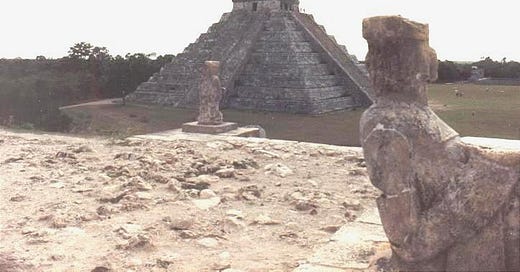



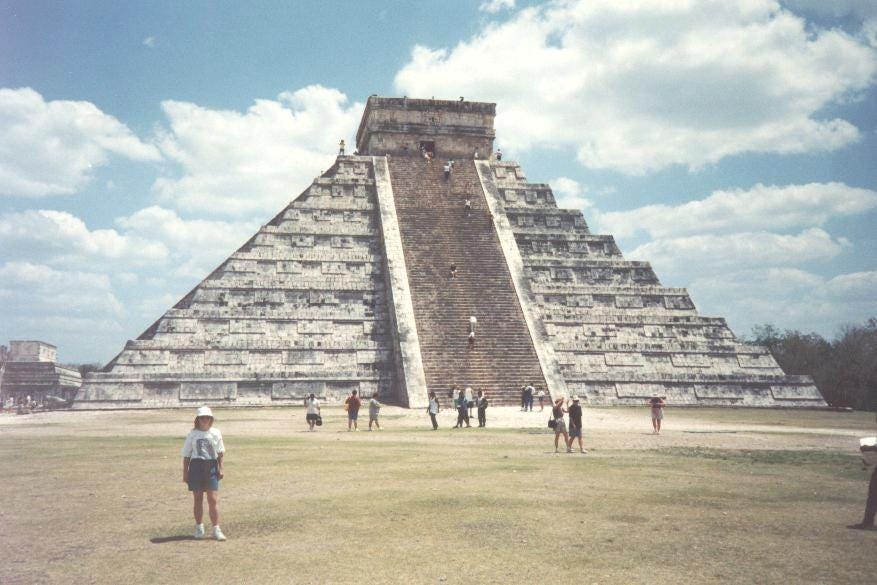
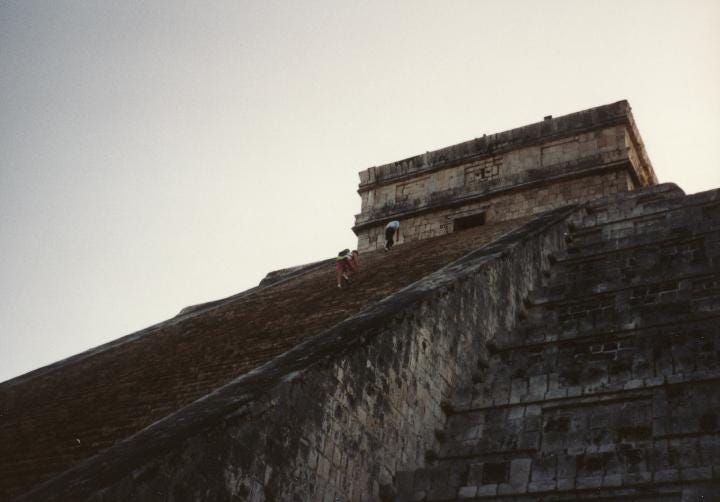
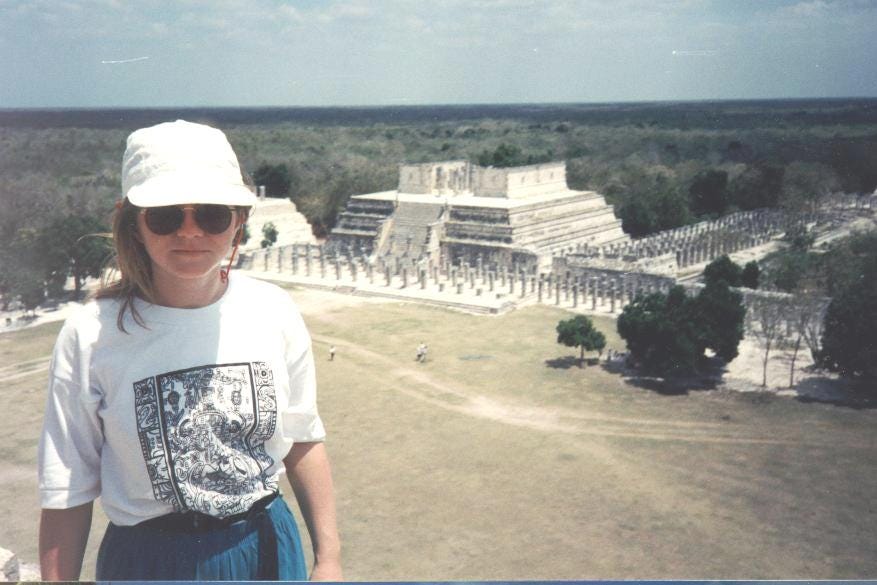
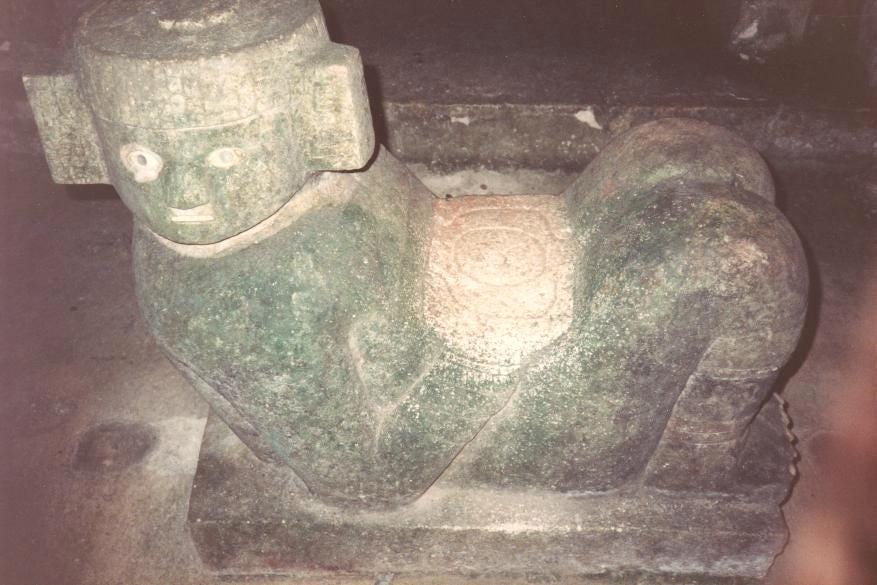
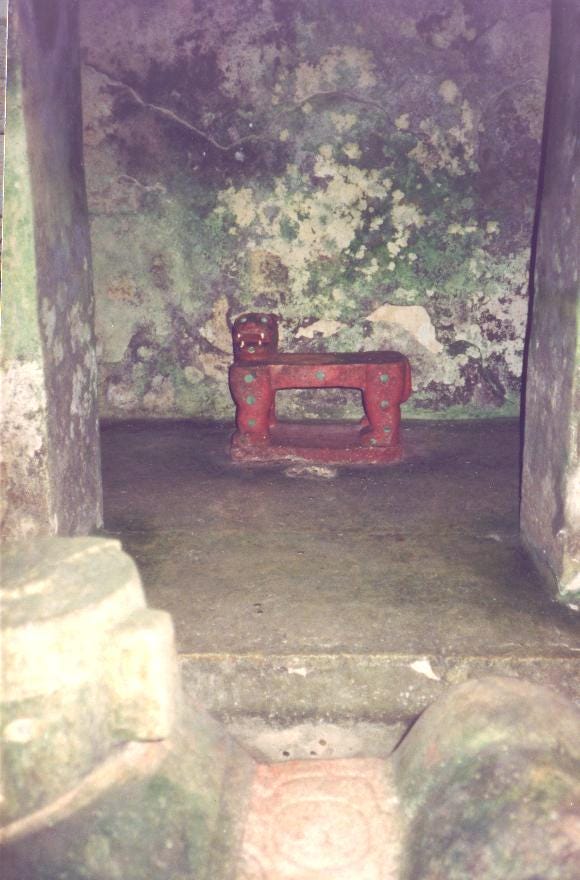
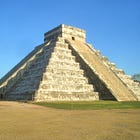
Some memories remain vivid forever. I love that.
Love that your feet perfectly fit those scary pyramid stairs, Emese! And you made it up and down, in one piece. It's so amazing, isn't it? 1995 -- 30 years --but the massive changes made in that amount of time. So happy you saw the real deal, and stayed in Piste! and met the German guy. You got the true lay of the land. Incredible.